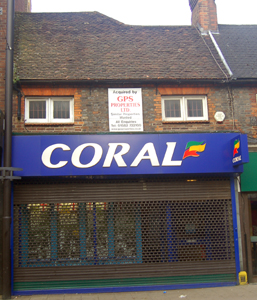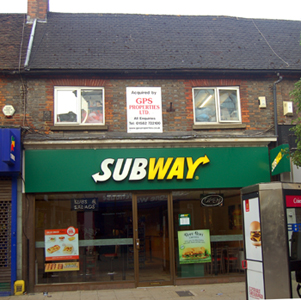The Old Bell Inn Luton

35 George Street June 2010
The Old Bell Public House: corner of Chapel Street and George Street
Luton had two establishments named The Bell, at least one of which is first mentioned at a very early date. One of these was later called The Old Bell and so one can only presume that this was the establishment with the longer pedigree.
The Bedfordshire Historic Environment Record [HER] has details of most historic buildings in the county. William Austin in his 1928 book The History of Luton and its Hamlets states that it was mentioned in the tenth year of Edward IV [1470-1471] presumably in manorial court rolls (Austin was the last steward to the Manor of Luton. The earliest reference found in documents held by Bedfordshire and Luton Archives and Records Service is in 1598 when land in Sewell Field in Houghton Regis was described as being owned by the Bell Inn, Luton [C145].
William Austin in Volume II of his History of Luton and its Hamlets, published in 1928 makes a number of references to the Old Bell. He notes that in a rate for mending highways and bridges, written between 1706 and 1711, the highest rated property was The Bell. He also refers to the Old Bell, along with the George and Red Lion, being the principal hotels of Luton in 1759. He states that the hotel was owned by the Trustram family, who had held it since at least the rating document referred to above.
Austin further states: "This inn was situate on the west side of George Street, at the corner of "Hog Lane" as it was then called, now Chapel Street, and extended as far as the premises of Mr. Arthur Day [43 George Street in 1928 - thus the Old Bell would have included 29-33, 35, 37, 39, 41 and 43 George Street]. The buildings still standing between the Westminster Bank and Mr. Day's property form part of the "Old Bell" buildings. There is still to be traced there the remains of a large malt-house occupied by the Trustrams; the place was originally an interesting structure of the Tudor period". Arthur Day's stood at 43/45 George Street and the Westminster Bank, on the corner of Chapel Street, at 31 George Street. Thus 35-39 George Street was part of the old inn. This building, now three shops, is not listed but certainly looks older than surrounding structures.
Confirmation for some of this can be found in 1727 when land and cottage in or near Hog Lane were conveyed [LHE138b]. The land and cottage were noted as bordering pasture belonging to the Bell to the west.
Austin states that the Old Bell was conveyed by the Trustram family to William Reeves in 1765, sold again in 1770 and again in 1788 to Richard Brown, maltster of Park Street "in the possession of whose descendants it has since remained and is now the property of Mr. Edward Brown. This gentleman has in his possession a lease of the old inn dated 1764. The hall, the ground-floor rooms, the bars, and the stairs had oak wainscoting". Austin transcribes the sale particulars of 1770 as follows:
"TO BE SOLD BY AUCTION, by Mr. Watson, on the premises, on Monday the 26th November, 1770, between the hours of Eleven and Two".
"That well-known, and old accustomed Inn, the BELL, at Luton in Bedfordshire, now in the Occupation of Francis Tuffnail, and Mr, John Cookson, tenants at Will, at the yearly rent of £29 (greatly under the value). The premises are Freehold, with a clear and good title, free from all and all Manner of Incumbrances whatsoever, and contain four Parlours, one Hall, two kitchens, a Bar and Bar-room, two Pantries, a Scullery, laundry, and two 'Ofterys' on the Ground Floor, 14 Bedchambers, and two light Closets above stairs, three good Cellars, Brew-house and Wood-house, Stabling for 50 Horses, with Hay lofts to ditto, two Large Barns and Hog Sties behind ditto, free from the house and Yard. Good Lofts, and other Conveniences, for a large Malting with very little alteration; a good Kitchen Garden enclosed, and a Dove Cote therein; a Close of Meadow Ground of one Acre and one Rood, more or less; one large Yard, convenient for any business, and two smaller well enclosed; a large Well with exceeding good Water, and always plenty, with a Pump fixt therein, and enclosed from the great Yard with Chinese Railing. The Buildings are 86 feet in front, and 204 feet deep, are chiefly built with bricks, and in good Repair".
"The premises are insured at £800 for seven Years, of which there are four Years and a Half to come, and the Purchaser becomes a Proprietor in the Hand-and-Hand Fire Office, by a premium paid to the said Office at the Time of Insurance for that Purpose, and the said Policy is made assignable thereby".
"PARTICULARS, with Conditions of Sale, may be had on Wednesday the 21st instant, at Mr. Hyatt's, Printer, at Bedford; at the Bull Inn at St. Alban's; at the Sun at Hitchin; at Mr. Watson's, Auctioneer, at Barnet, Herts; at the Place of Sale, and at the Swan with two Necks, St. John's Street, London".
"N. B. The possessing Tenants will show the Premises any Day before the Sale, Sundays excepted".
The Historic Environment Record quoted above goes on to say: "In the early 19th century it was a malting owned by the Browns, in 1828 it was destroyed by a storm." [HER 18094]. The inn, however, had ceased trading by 1828 as only one Bell is mentioned in the countywide register of alehouse licences between 1822 and 1828 and that is definitely The Bell on the other side of George Street, which had been trading as the Bell since at least 1788. No Old Bell is mentioned in the lists.
Austin noted that a rate-book for 1811 lists Richard Brown at "Ye Old Bell" in George Street, although it refers to the establishment as a malting and so it is impossible to say whether the house was still being run as an inn. If it was then this is the last surviving mention of it in that role.
William Austin recounts a flood in Luton on 8th July 1828: "The cause of this flood was the most alarming tempest of rain that had occurred within the memory of anyone then living. It began about six o'clock in the evening, accompanied by lightning and thunder, and continued with great violence for two hours, when there was a slight abatement. Presently the storm renewed itself with increasing fury, and water ran the whole width of the streets some six or seven inches deep … The Old Bell Inn on the western side of George Street also fared badly, and the foundations of the premises were so undermined that part of them had to be renewed; the garden walls at the back of the Inn completely collapsed".

37 George Street June 2010
Sources:
- C145: twelve year lease of land: 1598;
- X132/27: 1648;
- QSM various: 1717-1755;
- LHE138b: conveyance of land and premises near the Bell: 1727;
- QSR1728/15: regimental baggage for transport from the Bell to Hemel Hempstead [Hertfordshire: 1728;
- QSR1729/37: regimental baggage for transport from the Bell to Bedford: 1729;
- QSR1736/30,31: regimental baggage of His Majesty's Regiment of Horse to be moved from the Bell to Woburn: 1736;
- WB/Green7/7/1: LutonTown centre Historic Pubs and Breweries Trail pamphlet: 1990s.
Licensees: Note that this is not a complete list; italics indicate licensees whose beginning and/or end dates are not known
1541: William Child;
c. 1710: Trustram;
1770: Francis Tuffnail and John Cookson;
1811: Richard Brown?
Inn closed between 1811 and 1822?